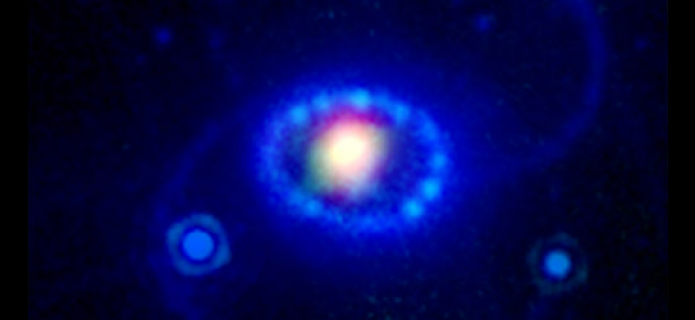Supernova Remnant Forging Copious Cold Molecules
5 August, 2013 / Read time: 4 minutes
Astronomers using ALMA, the Atacama Large Millimeter/submillimeter Array, have detected, for the first time, the formation of new molecules in the remains of a star that went supernova. By detecting and mapping the distribution of these molecules, the researchers also have caught a glimpse of the final internal structure of the star, which became "frozen in" to the debris when the star exploded.
The astronomers discovered these new molecules in the fading embers of a star that went supernova in 1987, known, conveniently, as 1987A. Located in the Large Magellanic Cloud, a nearby satellite galaxy of the Milky Way, supernova 1987A provides a unique opportunity to study how the aftermath of a supernova evolves. Computer models that attempt to recreate the conditions just prior to a supernova suggest that there is powerful and rapid mixing inside the star. This churning, astronomers speculate, is the trigger that sets off the explosion.
Since it's impossible to peer inside an actual star, astronomers study the debris of a supernova to see how material is distributed and how the remnant of the star evolves over time to infer the conditions just prior to the explosion. Earlier research with infrared telescopes detected a small amount of CO glowing hot within the first 500 days after the explosion. Twenty-five years later, the new ALMA results, which are the first of their kind, reveal a supernova environment filled with ten times the amount of CO detected by the infrared studies.
The astronomers estimate that there is about 10 percent the mass of our Sun in CO and also a significant mass of silicon monoxide (SiO) currently in the supernova remnant. These molecules are forming in areas with abundant atomic carbon, silicon, and oxygen atoms, elements that only form inside the nuclear furnace of a star and get spilled into the cosmos during a supernova explosion. Over time, as they cool, the atoms are able to bond, creating the CO and SiO that is detectable by ALMA. The molecules forming in SN1987A, or at least their constituent atoms, could someday be incorporated into future planets.
More Information
This research was presented in a paper "Carbon Monoxide in the Cold Debris of Supernova 1987A" was accepted for publication in the Astrophysical Journal Letters.
The team is composed of J. Kamenetzky, Univ. of Colorado at Boulder; R. McCray, University of Colorado; R. Indebetouw, National Radio Astronomy Observatory (NRAO); et al.
The Atacama Large Millimeter/submillimeter Array (ALMA), an international astronomy facility, is a partnership of the European Organisation for Astronomical Research in the Southern Hemisphere (ESO), the U.S. National Science Foundation (NSF) and the National Institutes of Natural Sciences (NINS) of Japan in cooperation with the Republic of Chile. ALMA is funded by ESO on behalf of its Member States, by NSF in cooperation with the National Research Council of Canada (NRC) and the Ministry of Science and Technology (MOST) in Taiwan and by NINS in cooperation with the Academia Sinica (AS) in Taiwan and the Korea Astronomy and Space Science Institute (KASI).
ALMA construction and operations are led by ESO on behalf of its Member States; by the National Radio Astronomy Observatory (NRAO), managed by Associated Universities, Inc. (AUI), on behalf of North America; and by the National Astronomical Observatory of Japan (NAOJ) on behalf of East Asia. The Joint ALMA Observatory (JAO) provides the unified leadership and management of the construction, commissioning and operation of ALMA.
Links
Contact:
Valeria Foncea
Education and Public Outreach Officer
Joint ALMA Observatory
Santiago, Chile
Tel: +56 2 2467 6258
Cell: +56 9 75871963
E-mail: [email protected]
Charles E. Blue
Public Information Officer
National Radio Astronomy Observatory
Charlottesville, Virginia, USA
Tel: +1 434 296 0314
Cell: +1 434.242.9559
E-mail: [email protected]
Richard Hook
Public Information Officer, ESO
Garching bei München, Germany
Tel: +49 89 3200 6655
Cell: +49 151 1537 3591
Email: [email protected]
Masaaki Hiramatsu
Education and Public Outreach Officer, NAOJ Chile
Observatory
Tokyo, Japan
Tel: +81 422 34 3630
E-mail: [email protected]
